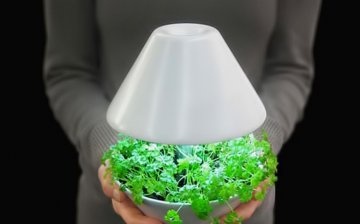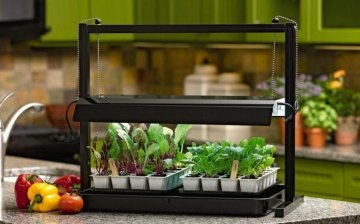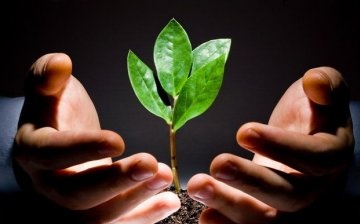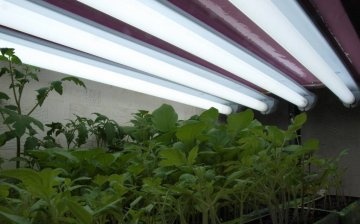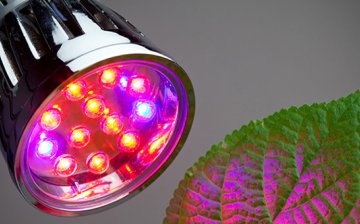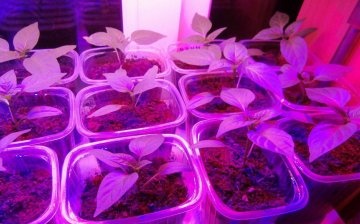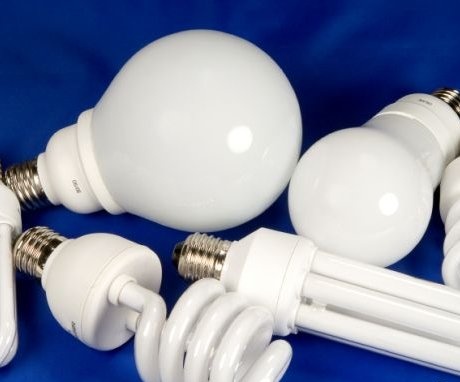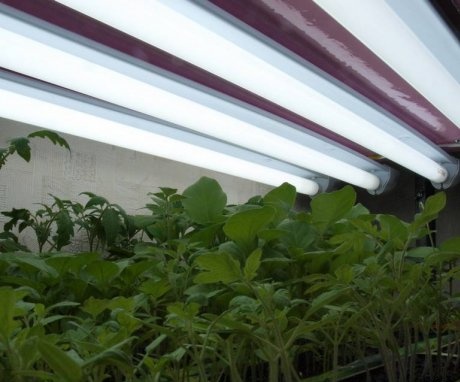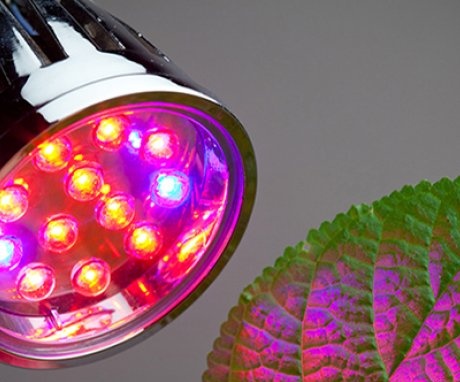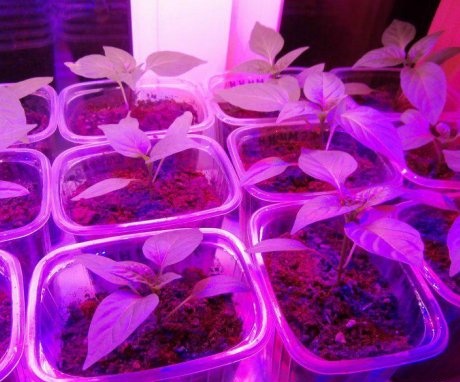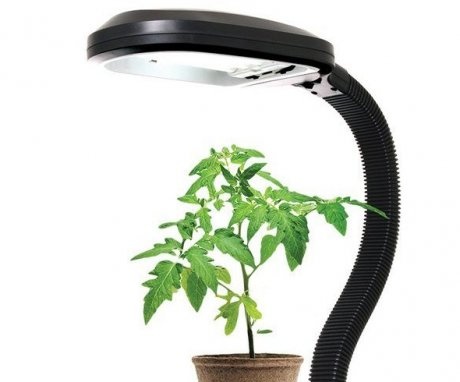Lighting for seedlings - types and rules of use
To grow seedlings - it's not easy. It stretches out, becomes pale or is affected by a fungal disease. However, experienced gardeners have learned how to grow strong and healthy seedlings. They know that the plant, first of all, needs light. Its lack does not allow full-fledged seedlings to grow.
Therefore, lighting plays a key role in the difficult business of growing seedlings. With its help, the sprouts receive everything they need to grow. Backlighting for plants is needed, despite the skeptical comments of some gardeners, they say it will grow anyway. Consider the question of choosing a lighting device for plants.
Content:
- Why do you need a light for seedlings
- Types of lighting fixtures
- Energy saving
- Luminescent
- Phytolamps
- How to install lamps correctly
- Using the backlight
- Gardeners' tricks
Why do you need a light for seedlings
Outdoors, plants receive the full spectrum of solar radiation. But placing them in a living space changes the picture. Culture does not receive the most useful radiation - blue and red. It is these spectra that contribute to the development of healthy, developed and strong seedlings. It is impossible to give them useful light in an apartment.
But the backlight solves the problem, it provides the plants with blue and red radiation - the sprouts do not stretch, do not fade or get sick.
The plant's immune system becomes stronger. Now it is clear why additional illumination of seedlings is needed. Moreover, it can help you grow plants all year round and provide them with full daylight hours, albeit artificial. Moreover, the red color helps the development of already grown seedlings, and the blue forms tiny, barely hatched sprouts, it participates in photosynthesis - the leaves acquire the same healthy green tint, and not pale.
We will not talk about the advantage and benefits of additional lighting, everything is clear without unnecessary arguments, it is necessary for plants just like water. Consider the types of lamps and figure out what to choose from a large assortment in garden centers.
Types of lighting devices
The correct choice of backlighting is based on calculating the number of lux and lumens per area occupied seedlings... First, you need to understand the most important characteristics of lamps - what is luxury and what is lumen. The latter denotes a unit that measures luminous flux. Lux shows the degree of illumination of 1 m2 luminous flux. It is on the suites that you need to pay attention when buying backlighting. Ideally, the number of suites should be at least 8000. If the area with seedlings is more than 1 m2, lamps are needed that would give a total of 8000 liters per square meter. m. That is, as a rule, one device is not enough.
A standard windowsill will need at least two lamps.
When choosing a backlight, you should also pay attention to the type of radiation - it must be red and blue without fail.The uniformity of lighting plays a big role, otherwise the plants will develop unevenly. So, there are several types of lighting devices:
- Energy saving
- Luminescent
- Phyto lamps
We will analyze each species and see what to choose for a home greenhouse for the benefit of green pets.
Energy saving
A popular type of backlighting among gardeners. It provides useful radiation and saves electricity, as the name of the lamp suggests. The backlight is inexpensive and lasts a long time. With its help, the gardener grows quite healthy and strong seedlings.
Energy saving lamps are the most common and widely used types of lighting in horticulture.
However, power-saving backlights are usually weak. Specifications indicate insufficient lux and lumens. Therefore, even a standard window sill will need 2-3 lamps or more, depending on the area. Otherwise, the plants will be drawn to the only "sun", which is not enough for everyone. The stems will be crooked and weak.
Luminescent
Another alternative type of lighting used by gardeners. It is certainly not intended specifically for seedlings, but its effectiveness has been evaluated and used.
When choosing these lamps, you should pay attention to the technical characteristics.
The color temperature index, which is indicated by the letter "K", must be above 4500. What does this mean? The higher this indicator, the more blue radiation the plant will receive. The 4,500 mark is associated with sunlight. Therefore, it is so important to pay attention to this parameter. A low rate will be of no use. Alternatively, a fluorescent lamp can be used for illumination, but of course it will not replace a phyto lamp.
Phytolamps
This type of lighting is designed specifically for flora and includes subspecies. We will dwell on them for a more detailed study. Allocate:
- LED. These lamps are very handy. These are small appliances that consume a small amount of electricity. The efficiency is large, it is considered the best option for lighting seedlings. The lamp takes into account all types of radiation that are necessary for the normal development of cultures.
- Metal halide. These devices are ideal for growing plants. They include useful emissions with good light transmission. Moreover, the efficiency of metal halide lamps is higher than that of mercury lamps. They use metal iodides, not just mercury.
- Sodium. These lamps are used for growing already adult seedlings. The fact is that the prevailing shade in the backlight is red. He is responsible for the immunity of culture, a set of strength in root system... However, it is also suitable for seedlings.
- Induction. They differ from their counterparts in the "endless" period of work - up to 100,000 hours. That is, once, having acquired such a lamp, you can forget about replacing or buying a new one - it will definitely be enough for the gardener's century. According to all characteristics, the lamp is optimally suited for illuminating plants. It emits both blue and red spectrum.
These types of lighting are actively used in specialized garden centers, greenhouses and conservatories. Experienced gardeners prefer them, since the lighting efficiency of phyto lamps is much superior to their counterparts.
All these types of phytolamps should be in the arsenal of a professional gardener, who does not deny the need for light for green pets, especially in early spring. They will help you grow healthy and strong seedlings.
How to install lamps correctly
The backlight setting is based on the technical specifications of the device. Remember suites and lumens? From their quantity and light transmission rates, lamps are installed. That is, the plant must receive enough light.
Even if a gardener has purchased an LED device with good characteristics, this does not mean that one lamp will be enough for a large area with seedlings. For a standard windowsill, for example, you will need two phyto lamps. Install them vertically, and not from the side or bottom.
Special devices do not heat, but illuminate, so there is no need to be afraid to lower the lamp over the plants.
The distance from the device to the plants will be approximately 30-40 cm, depending on the crop. If you install the lamps on the side, the seedlings will begin to bend towards the light, which is undesirable. If the leaves begin to turn brown at the edges, the lamp is too close. That is, look at the plants and adjust the distance between the lights.
The use of backlighting should be effective and useful. Therefore, it is important to follow the basic rules for the use of lighting equipment for seedlings. First of all, you need to consider the planting season:
- If it's February or even January, the backlight should be on daily - 4 hours in the morning and 4 hours in the evening. That is, you need to supplement the daylight hours to the standard summer day.
- There are much more daylight hours in March and April than on winter days. Therefore, it is more advisable to use lamps for 2-3 hours in the morning and evening.
Shoots that have just appeared, many of them illuminate around the clock. But this is not entirely correct. The biological process of development implies a period of rest - night. Plants also need it, like all living things. Therefore, the seedlings should be illuminated for the standard 12 hours, no more.
The backlight period will also fall on a day, on cloudy days. End of April, May does not require additional lighting. Seedlings are already taken out into fresh air for hardening, where the plants receive a daily rate of real sunlight. Backlight usage varies by region, planting period and daylight hours. Consider these factors. So lighting devices will give a useful and effective result.
Gardeners' tricks
When using fluorescent lamps, the light is scattered so much that crops do not receive the required solar diet. Experienced gardeners have come up with a trick - they build partitions from white Whatman paper or foil. These materials collect light and reflect it onto the seedlings. This way, useful lighting does not "scatter" around, but focuses on the plants.
If the containers are located on window sills, the lighting can be attached to special removable pins.
They are attached to the upper horizontal surface of the frame; lighting equipment is hung on them. At the end of the season, they are removed and removed until next spring.
It is advisable to place boxes with seedlings on the east or west windows. So you don't have to spend too much on electricity, despite the use of special lamps. The fact is that there is more sun in the west and east than in the north. Equipment usage time will be reduced by a couple of hours. The south side, although sunny, is not recommended for growing seedlings. Young seedlings can burn out on windowsills due to direct sunlight.
Illumination is needed for every gardener who is engaged in the cultivation of not only seedlings, but also all-season crops. Having figured out why it is needed and what types of lighting lamps are suitable for green pets, you can purchase helpers for growing healthy and strong seedlings. Also, don't forget about simple, basic rules. leaving for young seedlings.
More information can be found in the video:



